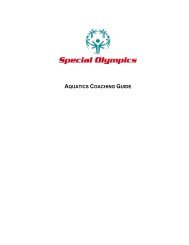BADMINTON Special Olympics Sports Skills Program
BADMINTON Special Olympics Sports Skills Program
BADMINTON Special Olympics Sports Skills Program
You also want an ePaper? Increase the reach of your titles
YUMPU automatically turns print PDFs into web optimized ePapers that Google loves.
Basic Skill #4<br />
Ready Position<br />
Getting into a good ready position is essential to maximize<br />
player performance.<br />
Assessment of Each Athlete’s Current Skill Level<br />
Beginners will have a tendency to stand with the racket held<br />
down below the waist and to stand in a position where the<br />
legs are mostly straight. Intermediate to advanced players<br />
demonstrate a consistent ready position with the racket held<br />
above waist level and the legs and trunk in a flexed position.<br />
Steps to Teach the Ready Position<br />
Show good ready positions for serving, receiving serve and<br />
just prior to the opponent returning the shuttle in play<br />
situations.<br />
Practice correct ready positions with all skill drills and play<br />
situations (Figure 12).<br />
Cue Words<br />
• On your toes<br />
• Knees bent<br />
• Racket up<br />
Figure 12<br />
Suggestions for the Te a c h e r / C o a c h<br />
Use humor and positive reinforcement to<br />
continually remind athletes about the importance<br />
of a good ready position.<br />
<strong>Special</strong> <strong>Olympics</strong> Badminton <strong>Sports</strong> <strong>Skills</strong> <strong>Program</strong><br />
Basic Skill #5<br />
Serve Returns<br />
P l ayers must be able to return serves to successfully enjoy<br />
game play. Both short and long serve returns are included here.<br />
Assessment of Each Athlete’s Current Skill Level<br />
B eginners will have difficulty making consistent contact with a<br />
s e rved shuttle. Intermediate players will be able to consistently<br />
s t r i ke the shuttle and return it to the opponent’s side of the<br />
c o u rt .<br />
Steps to Teach Serve Returns<br />
• The player should stand slightly sideways with the<br />
opposite foot of the racket hand forward.<br />
• As soon as the server makes contact with the shuttle,<br />
the receiver should move in the direction of the hit.<br />
• If the shuttle is struck overhead in the net area, simply<br />
teach players to push forward in the direction of the<br />
shuttle. Adjust how hard the bird is struck to vary the<br />
distance of the return, and adjust the angle of the racket<br />
face to alter hitting direction.<br />
• If the shuttle is struck overhead in the back court,<br />
execute the appropriate overhead stroke of choice.<br />
(See Forehand Overhead Clear, Drop, and Smash Skill<br />
Technique Sections.)<br />
Drills<br />
1. Short Serve Return Target<br />
Identify six target areas as shown in Diagram 2 that are larg e<br />
t a rgets to begin with (approx i m a t e ly 1 square meter); reduce<br />
size as skills improve; increase size if limited success is<br />
evident. One partner serves while the other partner attempts<br />
to return serve into the six different targets. Try to hit one<br />
t a rget several times before moving on to a different targ e t .<br />
After a 40-60 percent success rate with most of the targets,<br />
challenge the athlete to hit a different target after each<br />
practice serve to judge control.<br />
2. Long Serve Return Target<br />
Use the same target drill as the short serve return target drill<br />
p r ev i o u s ly described for use with clear, drop, and smash return s .<br />
Cue Words<br />
• Ready position<br />
• Watch the bird<br />
• Aim at target<br />
3 1

















